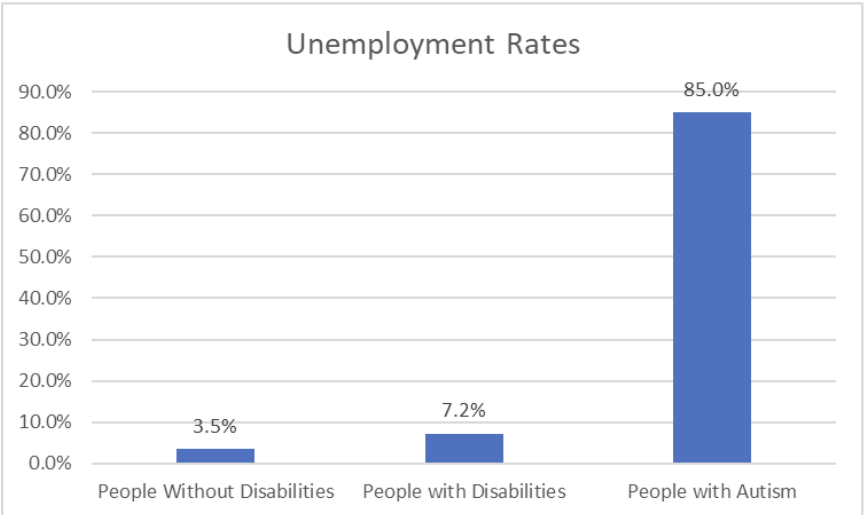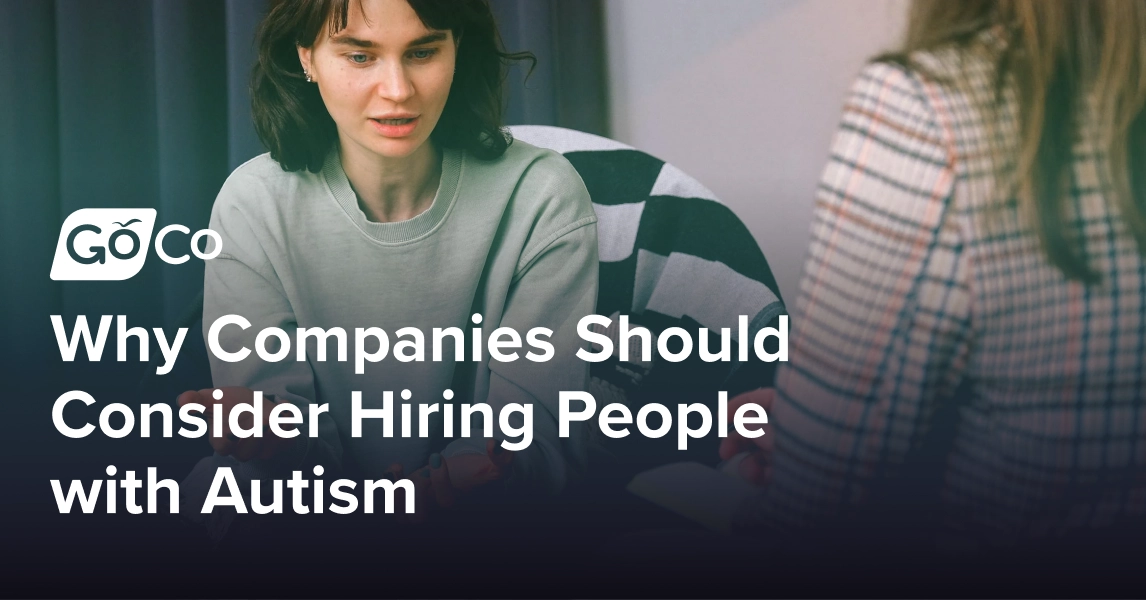Why Companies Should Consider Hiring People with Autism
An overview of the qualities that people with autism can bring to companies, the difficulties they may face in traditional interview settings, and how companies can make accomodations.
by Miriam Edelman - July 8th, 2024
Human Resource professionals are tasked with helping employers secure one of their most important resources: staff. However, far too often, people with disabilities, especially those with autism, are not given a chance for employment in their chosen field and in jobs they are qualified for. As a result, people with autism experience up to an 85% unemployment rate.
Members of this population are the most unemployed group with disabilities. The following graph shows very disparate employment rates of different groups of people.
 In addition, many people with autism are underemployed. It is common for them to have part-time jobs or do work that they are overqualified for. This article examines the qualities that people with autism can bring to companies, the difficulties they may face in traditional interview settings, and how companies can make accomodations in the interview process.
In addition, many people with autism are underemployed. It is common for them to have part-time jobs or do work that they are overqualified for. This article examines the qualities that people with autism can bring to companies, the difficulties they may face in traditional interview settings, and how companies can make accomodations in the interview process.
What is Autism?
Autism is a developmental disability marked by atypical communication and behaviors that can impede autistic people’s ability to secure proper employment. They can speak differently (in terms of rhythm, inflection, tempo, and volume) than allistic (non-autistic) individuals. They can also have trouble making eye contact and can stim (i.e. – engage in repetitive movement).
People with autism are a growing, largely untapped labor pool. In recent years, the autism rate increased sharply from around one in 150 eight-year-olds in 2000 to approximately one in 36 eight-year-olds in 2020. Approximately one in 45 adults in the United States has autism. For this reason, hiring practices should be reviewed and modified to include this population.
How People with Autism Can Be Valuable Employees
If hired, people with autism can be exceptional employees, contributing in ways that other workers cannot. They can be up to 140 percent more productive than others when properly matched to a job. In addition, they can hyperfocus and pay close attention to detail. They also can use their good memory. Their creativity can cause them to problem-solve well and develop new and innovative ideas. Other positive attributes include being honest and loyal, reliable, and good rule-followers.
Employees with autism have proved that they can be extremely valuable and sometimes can create systems that increase their office’s efficiency. For example, Nicolas Neumann saw that his office was forced to manually input large amount of money into an invoicing system and authorize spending. After Neumann taught himself how to code, he built software to automate this procedure. His program dramatically decreased the average time to work on an invoice from multiple days to 20 minutes.
People with Autism are Often Not Given a Chance
Yet, despite potentially possessing strengths as employees, all too often, people with autism are not given a chance. They might have excelled in school, but they have trouble getting their foot in the door. Therefore, they might have one or more lengthy employment gaps, which can prevent them from even getting interviews.
It is not uncommon for people with autism to have lengthy employment gaps due to autism-related problems. They can apply for years for employment and fail to get a job. Hence, they can have atypical backgrounds for jobs: being both overqualified (in terms of education) and underqualified (in terms of work experience). It could be difficult to determine what is the best job for them. During interviews, applicants with autism can be questioned about their atypical work history, possibly causing these individuals immense stress and/or resulting in them to be defensive. Human resources professionals should be more open to applicants with employment gaps and give them fair chances.
Many times, employers might not identify autism as a reason for long periods of sustained unemployment. Wary about gaps, employers might refuse to give people with autism a chance. They might incorrectly link these gaps to the following: something bad occurred at the last office, the applicant does not have good professional judgment, the possible employee has problems with commitment, they cannot get along with co-workers, they might interview well but not have good references, they are lazy, their skills might not be useful, and/or their expertise is out of date.
Frequently, applicants with autism cannot get past the interview stage to a job offer. Interviews can be very difficult for most people but much harder for people with people with autism. Autism-related traits put individuals with autism at a disadvantage regarding conversational and nonverbal parts of interviews. People with autism can have difficulties with the conversation itself, have trouble with eye contact, and stim. Some hiring managers can view autism manifestations, such as weak body language, as dealbreakers and make snap-judgements that these potential employees often are not able to overcome.
Interviews can be extremely stressful for potential employees with autism, especially if those people have had many interviews without a single job offer. They could feel anxiety about interviews, knowing that the interview stage is where they have been failing. They could be frustrated, as they may know how to interview well and have received positive feedback during interviews. Demoralized, they might feel that whatever they do, they will never get a job. This low self-confidence could come across in interviews.
Human resources professionals and business leaders should be prepared for applicants with autism to say they have autism. Such disclosures might not happen every time. These disclosures should not scare employers and/or cause them to write these applicants off. Instead, they could provide context about the reasons for the applicant’s employment issues.
How to Make the Hiring Process More Inclusive
Employers can change hiring processes to make it easier for everyone, including applicants with autism, shine. They can do the following:
Write job descriptions with inclusive and accessible language. Do not use jargon and lengthy sentences.
Ask if applicant needs reasonable accommodations.
Allow applicant to choose the communication method.
Train interviewers and others to not have a non-verbal bias during interviews and to respect silence from candidates during conversations.
During video interviews, enable closed captioning.
Do not force applicants to go on camera (at least during initial interviews). – Thus, people with autism would not be judged for atypical body language.
Describe the interview’s agenda and possibly questions and topics.
If having a virtual interview, type and ask questions. – Seeing the questions could decrease nerves.
Decrease the number of people conducting the interview at the same time (Instead, hold sequential interviews for the applicant.)
Invite a person (who the applicant knows) or a disability-related professional to the interview (Those people can help explain questions to the applicant.).
Do not force the applicant to shake hands in an in-person interview.
Allow the applicant to hold an object (i.e. – a stress ball).
Ask literal instead of abstract questions.
Ask follow-up questions to let the applicant elaborate.
Let applicant have time to comprehend interview questions.
Require more applicants to complete writing tasks that are similar to the job’s assignments – Applicants can prove they would be able to succeed in the position and thus could be less hurt by potentially not-so-good interview performances. Employers could learn from Ernst & Young, whose hiring process sometimes includes applicants completing tasks that allow them to demonstrate their skills instead of answering at least some typical interview questions.
Final Thoughts
As gate-keepers, human resources professionals and business leaders have the ability and power to create more inclusive organizations. They should be more understanding and less judgmental of potential autism-related challenges, recognize the immense strengths of some people with autism, and change their hiring practices. This way, they can achieve one of their ultimate goals: Securing the best staff.
Recommended Posts
Five Best Practices for ADA Compliance
Blog Articles
7 Tips for Supporting Neurodiversity in the Workplace
Blog Articles
Search...
Product
GoCo
Resources
Articles
eBooks
Webinars
Customer Stories






